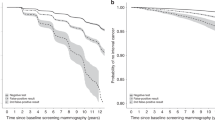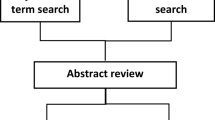Abstract
Objective
To examine risk factors for interval breast cancer among women screened in a population-based mammography program.
Methods
Risk for interval cancer was assessed in terms of both the incidence per 10,000 negative screens and the proportion of all breast cancers diagnosed among screened women. Interval (N = 557) and screen-detected cancers (N = 1,545) were identified among 208,667 women receiving mammography in Colorado (1994–2001). Logistic regression was used to assess independent effects of multiple factors.
Results
Overall risk of interval cancer was 29.5/10,000 women screened. Incidence was higher in women >50 years (OR: 2.28, 1.86–2.80), with family history (OR: 2.23, 1.85–2.70), with dense breasts (OR: 3.84, 2.76–5.35), and using hormones (OR: 1.54, 1.20–1.97). Hispanics had lower incidence than Whites (OR: 0.52, 0.34–0.81). Interval cancers represented 26% of all cancers diagnosed. This proportion was higher in women <50 (OR: 1.41, 1.09–1.82) and in women with dense breasts (OR: 2.95, 1.94–4.48).
Conclusions
Incidence of interval cancer increases with age, breast density, hormone use, and family history. Attempts to reduce occurrence of these cancers through more sensitive and/or intensive screening should focus on these subgroups. The disproportionate number of interval cancers associated with young age and dense breasts suggests these cancers result from both rapid growth and difficulties in detection.
Similar content being viewed by others
References
Porter PL, El-Bastawissi AY, Mandelson MT et al (1999) Breast tumor characteristics as predictors of mammographic detection: comparison of interval- and screen-detected cancers. J Natl Cancer Inst 91(23):2020–2028
Gilliland FD, Joste N, Stauber PM et al (2000) Biologic characteristics of interval and screen-detected cancers. J Natl Cancer Inst 92(9):743–749
Crosier M, Scott D, Wilson RG, Griffiths CD, May FE, Westley BR (2001) High expression of the trefoil protein TFF1 in interval breast cancers. Am J Pathol 159(1):215–221
Raja MA, Hubbard A, Salman AR (2001) Interval breast cancer: is it a different type of breast cancer? Breast 10(2):100–108
Crane CE, Luke CG, Rogers JM, Playford PE, Roder DM (2002) An analysis of factors associated with interval as opposed to screen-detected breast cancers, including hormone therapy and mammographic density. Breast 11(2):131–136
Burrell HC, Sibbering DM, Wilson A et al (1996) Screening interval cancers: mammographic features and prognosis factors. Radiology 199(3):811–817
Klemi PJ, Toikkanen S, Rasanen O, Parvinen I, Joensuu H (1997) Mammography screening interval and the frequency of interval cancers in a population-based screening. Br J Cancer 75(5):762–766
Schroen AA, Wobbes T, van der Sluis RF (1996) Interval carcinomas of the breast: a group with intermediate outcome. J Surg Oncol 63(3):141–144
Mandelson MT, Oestreicher N, Porter PL (2000) Breast density as a predictor of mammographic detection: comparison of interval and screen-detected cancers. J Natl Cancer Inst 92(13):1081–1087
Carney PA, Migliorettty DL, Yankaskas BC et al (2003) Individual and combined effects of age, breast density, and hormone replacement therapy use on the accuracy of screening mammography. Ann Intern Med 138:168–175
Wang H, Bjurstam N, Bjorndal H et al (2001) Interval cancers in the Norwegian Breast Cancer Screening Program: frequency, characteristics and use of HRT. Int J Cancer 94:594–598
Brekelmans CT, Peeters PH, Faber JA, Duerenberg JJ, Collette HJ (1994) The epidemiologic profile of women with an interval cancer in the DOM screening programme. Breast Cancer Res Treat 30(3):223–232
Kerlikowske K, Grady D, Barclay J, Sickles EA, Ernster V (1996) Effect of age, breast density, and family history on the sensitivity of first screening mammography. JAMA 276:33–38
Kavanagh A, Mitchell H, Giles G (2000) Hormone replacement therapy and the accuracy of mammographic screening. Lancet 355:270–274
Nixon RM, Pharoah P, Tabar L et al (1999) Mammographic screening in women with a family history of breast cancer: some results from the Swedish two-county trial. Rev Epidemiol Sante Publique 48:325–333
Kerlikowske K, Carner PA, Geller B et al (2000) Performance of screening mammography among women with and without a first-degree relative with breast cancer. Ann Intern Med 133:855–863
Halapy E, Chiarelli AM, Klar N, Knight JA (2005) Accuracy of breast screening among women with and without a family history of breast and/or ovarian cancer. Breast Ca Rsch Treat 90:299–305
Surveillance, Epidemiology and End Results (SEER) (2004). National Cancer Institute, U.S. National Institutes of Health
Elledge RM, Clark GM, Chamness GC, Osborne CK (1994) Tumor biologic factors and breast cancer prognosis among White, Hispanic and Black women in the United States. J Natl Cancer Inst 86(9):705–712
Jones BA, Kasl SV, Curnen MG, Owens PH, Dubrow R (1995) Can mammography screening explain the race difference in stage at diagnosis of breast cancer? Cancer 75(8):2103–2113
Hunter CP, Redmond CK, Chen VW et al (1993) Breast cancer: factors associated with stage at diagnosis in black and white women. Black/White Cancer Survival Study Group. J Natl Cancer Inst 85(14):1129–1137
Jacobellis J, Cutter G (2002) Mammography screening and differences in stage of disease by race/ethnicity. Am J Public Health 92(7):1144–1150
Nixon AJ, Neeuberg D, Hayes DF (1994) Relationship of patient age to pathologic features of the tumor and prognosis for patients with stage I or II breast cancer. J Clin Oncol 12:888–894
Eerola H, Heikkila P, Tamminen A, Aittomaki K, Blomqvist C, Nevanlinna H (2005) Histopathological features of breast tumours in BRCA1, BRCA2 and mutation-negative breast cancer families. Breast Cancer Res 7(1):R93–R100
Phillips KA, Nichol K, Ozcelik H et al (1999) Frequency of p53 mutations in breast carcinomas from Ashkenazi Jewish carriers of BRCA1 mutations. JNCI 91:469–473
U.S. Census Bureau, Population Division, 2002
Hofvind S, Moller B, Thoresen S, Ursin G (2006) Use of hormone therapy and risk of breast cancer detected at screening and between mammographic screens. Int J Cancer 118:3112–3117
Loman N, Johannsson O, Kristoffersson U, Olsson H, Borg A (2001) Family history of breast and ovarian cancers and BRCA1 and BRCA2 mutations in a population-based series of early-onset breast cancer. JNCI 93(16):1215–1223
Olsen AH, Bihrmann K, Jensen MB, Vejborg I, Lynge E (2009) Breast density and outcome of mammography screening: a cohort study. Br J Cancer 100(7):1205–1208
Kavanaugh A, Byrnes GB, Nickson C et al (2008) Using mammographic density to improve breast cancer outcomes. CEBP 17(10):2818–2824
McTiernan A, Martin CF, Peck JD et al (2005) Estrogen-plus-progestin use and mammographic density in postmenopausal women: Women’s Health Initiative randomized trial. J Natl Cancer Inst 97(18):1366–1376
Rossouw JE, Anderson GL, Prentice RL et al (2002) Risks and benefits of estrogen plus progestin in healthy postmenopausal women: principle results from the Women’s Health Initiative randomized controlled trial. JAMA 288:321–333
Chlebowski RT, Hendrix SL, Langer RD et al (2003) Influence of estrogen plus progestin on breast cancer and mammography in healthy postmenopausal women: the Women’s Health Initiative Randomized Trial. JAMA 289(24):3243–3253
Nicholson BT, LoRusso AP, Smolkin M, Bovbjerg VE, Petroni GR, Harvey JA (2006) Accuracy of assigned BI-RADS breast density category definitions. Acad Radiol 13(9):1143–1149
Taylor R, Supramaniam R, Rickard M, Estoesta J, Moreira C (2002) Interval breast cancers in New South Wales, Australia, and comparisons with trials and other mammographic screening programmes. J Med Screen 9(1):20–25
Moskowitz M (1986) Breast cancer: age-specific growth rates and screening strategies. Radiology 161:37–41
Tabar L, Chen HH, Fagerberg G, Duffy SW, Smith TC (1997) Recent results from the Swedish Two-County Trial: the effects of age, histologic type, and mode of detection on the efficacy of breast cancer screening. J Natl Cancer Inst Monogr 22:43–47
Duffy SW, Day NE, Tabar L et al (1997) Markov models of tumor progression: some age-specific results. J Natl Cancer Inst Monogr 22:93–97
Tabar L, Fagerberg G, Duffy SW (1995) Efficacy of breast cancer screening by age. New results from the Swedish Two-County Trial. Cancer 75(10):2507–2517
Buist DS, Porter PL, Lehman C, Taplin SH, White E (2004) Factors contributing to mammography failure in women aged 40–49. J Natl Cancer Inst 96(19):1432–1440
Nickson C, Kavanagh AM (2009) Tumor size at detection according to different measures of mammographic breast density. J Med Screen 16(3):140–146
Roubidoux MA, Bailey JE, Wray LA, Helvie MA (2004) Invasive cancers detected after breast cancer screening yielded a negative result: relationship of mammographic density to tumor prognostic factors. Radiology 230(1):42–48
Guo YP, Martin LJ, Janna W, Banerjee D (2001) Growth factors and stromal matrix proteins associated with mammographic densities. CEBP 10:243–248
Gill KS, Yankaskas BC (2004) Screening mammography performance and cancer detection among black women and white women in community practice. Cancer 100(1):139–148
Rosenberg RD, Lando JF, Hunt WC et al (1996) The New Mexico Mammography Project Screening mammography performance in Albuquerque, New Mexico, 1991 to 1993. Cancer 78(8):1731–1739
Poplack SP, Tosteson AN, Grove MR, Wells WA, Carney PA (2000) Mammography in 53, 803 women from the New Hampshire mammography network. Radiology 217(3):832–840
Gower-Thomas K, Fielder H, Branston L, Greening S, Beer H, Rogers C (2002) Reviewing interval cancers: Time well spent? Clin Radiol 57:384–388
McCann J, Britton PD, Warren RML, Hunnam G (2001) Radiological peer review of interval cancers in the East Anglian breast screening programme: what are we missing? Jr Med Screen 8(2):77–83
Klemi PJ, Toikkanen S, Rasanen O, Parvinen I, Joensuu H (1997) Mammography screening interval and the frequency of interval cancers in a population-based screening. Br Jr Cancer 75(5):762–766
Raja MA, Hubbard A, Salman AR (2001) Interval breast cancer: is it a different type of breast cancer? Breast 10(2):100–108
Acknowledgments
We would like to acknowledge the Colorado Mammography Project (NCI grant # 5U01 CA63736-10) and the project staff for providing access to these data for this analysis. This work was supported in part by an Endowed Chair through the University of Colorado Comprehensive Cancer Center and a grant from the Colorado Department of Public Health and Environment.
Author information
Authors and Affiliations
Corresponding author
Additional information
This work was performed at The University of Colorado Denver.
Rights and permissions
About this article
Cite this article
Lowery, J.T., Byers, T., Hokanson, J.E. et al. Complementary approaches to assessing risk factors for interval breast cancer. Cancer Causes Control 22, 23–31 (2011). https://doi.org/10.1007/s10552-010-9663-x
Received:
Accepted:
Published:
Issue Date:
DOI: https://doi.org/10.1007/s10552-010-9663-x




